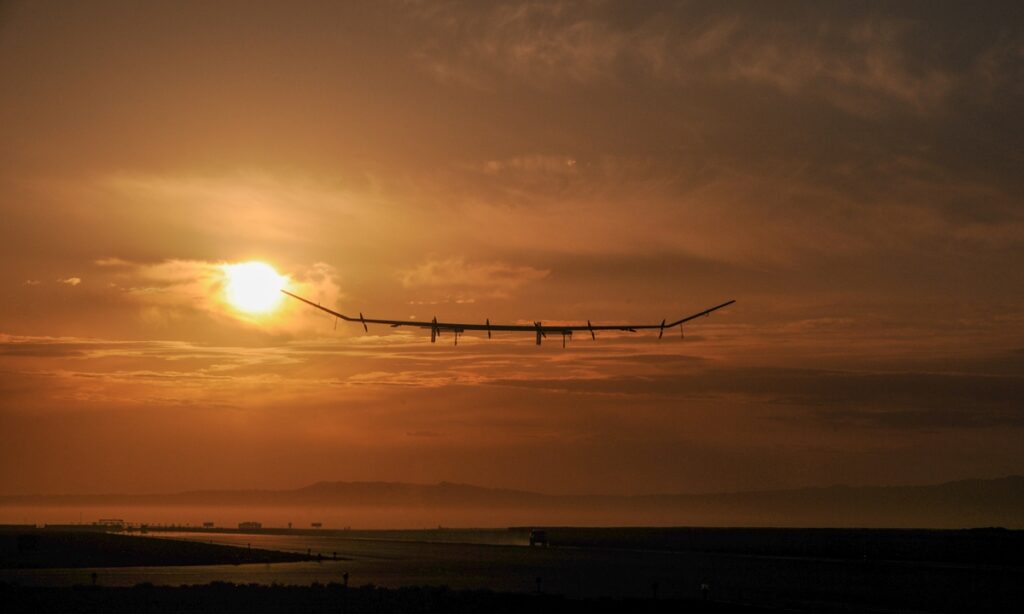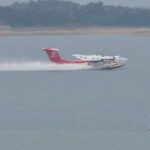UAV to act as quasi-satellite for recon, monitoring, communications relay missions
China is expected to unveil its next-generation, solar-powered large unmanned aerial vehicle (UAV) with very long endurance soon, which will have a larger wingspan than its predecessors that allows it to carry larger payloads for missions including reconnaissance, monitoring and communications relay in near-space, said Chinese experts familiar with the matter on Monday.
The remarks came after the country’s latest drone of this kind made its maiden flight earlier this month.
In 2017, China’s first solar-powered large drone, the CH-T4 of the world-famous CH drone series, made its maiden flight, staying aloft for 15 hours at altitudes of more than 20,000 meters. This made China the third country to develop such an aircraft following the UK and the US.
Having a wingspan of around 45 meters, the CH-T4 has set a very high starting point for China’s solar-powered drone development, with all core technologies and equipment being domestically made, a source familiar with the Chinese drone industry told the Global Times on condition of anonymity.
Earlier this month, the Qimingxing-50 solar-powered drone, developed by Aviation Industry Corporation of China (AVIC), made its maiden flight. It has a 50-meter-class wingspan and can also reach 20,000 meters in altitude.
The Qimingxing-50 is the first high-altitude low-speed drone with an ultrahigh aspect ratio developed by the AVIC, the first large drone to use a twin-fuselage configuration, and the first all-electric large UAV platform with solar energy as the only power source.
An even larger solar-powered drone, with a wingspan of over 60 meters, a service ceiling of more than 20,000 meters, an endurance of more than a month and a mission payload of 30 kilograms was unveiled by CH UAV company in its information material at Airshow China 2021, which was held in September in Zhuhai, South China’s Guangdong Province.
Based on the general pattern and development cycle, China’s new-type solar-powered drone, which has a larger wingspan and can carry larger payloads, could make its debut at the upcoming Airshow China 2022 in November, Fu Qianshao, a Chinese aviation expert, told the Global Times on Monday.
From the CH-T4 to the Qimingxing-50, then to the next-generation solar-powered drone, wingspans are getting larger and larger, expanding from 45 meters to 50 meters then to more than 60 meters.
A larger wingspan will allow the drone to carry more solar panels to provide sufficient electricity to support the extended flight, Fu said. Larger and more capable payloads also use more electricity, he pointed out.
As long as the electricity generated during the day is enough to support the drone’s flight overnight, the drone can remain in the sky for months, Fu said.
Another reason to have a larger wingspan is that it will provide a higher lift-drag ratio for the aircraft, extending its endurance, the expert said.
The developers must have resolved issues related to structural strength so that a larger wing would not break, Fu said. “More advanced solar batteries will also be installed, which will also contribute to the power generation.”
Other countries like the US have developed solar-powered drones, including NASA’s Helios, which has a wingspan of about 75 meters, and Odysseus, which is a product of a Boeing subsidiary with a wingspan of 74 meters.
Generally speaking, China’s development in solar-powered large UAVs can rival its foreign counterparts, Fu said.
Another expert who asked for anonymity told the Global Times that solar-powered drones can play very important roles in both military and civilian fields, including in missions like reconnaissance, surveillance, communications relay, forest firefighting and maritime monitoring.
Because such drones have the potential to stay in the air for months and even years at near-space altitudes, they can act as quasi-satellites, the expert said. They also have advantages over other types of aircraft.
Compared with satellites, solar-powered drones are more accurate, can theoretically remain in mission areas permanently and have lower operating costs.
Compared with traditional aircraft, solar-powered drones can cover larger areas and have longer endurance.
Compared with aerostatics, solar-powered drones are more maneuverable, the expert said. If needed, a fleet of solar-powered drones carrying different payloads can also be deployed to meet different mission requirements, he said.
Solar-powered drones can focus on a specific area for a long time, or they can conduct patrols over 2,000 or 3,000 kilometers. They can also be used jointly with satellites, which will yield even better results, the expert said.
When serving civilian purposes, like providing communications signals for remote regions, solar-powered drones are more cost-effective than setting up base stations on the ground. This method is even better than the US’ Starlink satellites, the expert said.
(Global Times)




